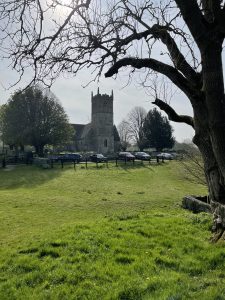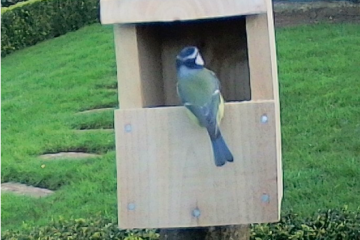Sunday 15th May 10.00-11:30
St Mary the Virgin Church, West Kington

West Kington Church, Easter Day (credit: Amanda Read)
Invitation from Julia Howey
If you would like to find out more about nature in our parish, please join us for a guided walk (1.5 hrs approx) looking at river banks, grassland, woodland and verges. We will meet at 10am at West Kington Church where we will begin by looking at the churchyard.
We will be led by Ann Skinner who, amongst other roles, has worked for various Wildlife Trusts and the Environment Agency. She is a font of information; on a recent walk along Wood Lane we were able to identify 32 flowering plants in the verges! She has written for us a short description of ‘WHAT MAKES NETTLETON PARISH SO SPECIAL FOR NATURE’ which includes links to find out more or do something ourselves. (see Further Information heading below).
Parking
Car parking there is limited but Jane Holderness-Roddam has very kindly said that we can park in the area at the far end of the ménage as long as the gate into it is not blocked. She has also offered to open a field for parking if necessary so I’d be grateful if you could leave a comment below if you intend to drive so this can be arranged beforehand.
Country Code
She has also requested that no one feeds the horses and that gates are left closed. The walk is not suitable for lots of dogs so please do not bring yours unless it is an Assistance Dog.
Plant a Tree for the Jubilee
More generosity comes from Mark Jackson of West Kington Nursery. He is offering 100 free trees to children (16 or under) in the parish as part of the Plant a Tree for the Jubilee campaign. They will be available for collection at the Parish Party. Let’s contribute to the Queen’s Green Canopy!
For more information download the attached pdf:
what makes nettleton parish so special for wildlife
Further information: WHAT MAKES NETTLETON PARISH SO SPECIAL FOR NATURE?
Situated in the beautiful landscape of Wiltshire’s southern Cotswolds, the land within the parish boundary is exceptionally rich in wildlife. This is because of the intimate mosaic of habitats present, some of which will be explored during our walk.
The By Brook and its tributaries formed the landscape of interlocking valleys after the retreat of shallow seas under which the fossil-rich oolitic limestone was formed. The clean and clear water supports fish such as brown trout and the diminutive bullhead, the only freshwater fish known to echolocate. Male bullheads are highly territorial and guard their eggs carefully to keep them safe from predators and infection. Sadly, the number of nesting dippers (the only British bird that can walk under water) has declined in recent years and the majority of native crayfish populations have been lost due to introduced signal crayfish and the fungal infection they carry. Heron and kingfisher are still a fairly common sight, while numbers of little egrets are increasing. The Bristol Avon Rivers Trust works to protect the rivers for people and wildlife https://bristolavonriverstrust.org/
Much of the employment and wealth in this part of Wiltshire came from the woollen industry – the By Brook once powered 15 mills, cleaning the fleeces prior to being spun and woven into cloth. Most people were employed as shepherds and weavers, or worked on farms and in the woodlands.
Many of the woodlands are tiny remnants of the wildwood which clothed the land before being cleared for agriculture. Continuously wooded since the last Ice Age, ancient woodlands are indicated by the presence of spring flowers such as bluebells (a globally rare species) and the pure white wood anemone, both flowering early before the tree canopy closes over. Woodlands were carefully managed in mediaeval times – oak and ash trees were periodically thinned to provide material for building houses and making tool handles; the hazel shrub layer was coppiced to provide kindling for bread ovens, thin pliable poles for making hurdles to control sheep, and the lath and plaster walls in buildings.
The limestone grasslands were created through centuries of sheep grazing and are rich in different species of wildflowers which in turn support many butterflies. Regular grazing is essential to remove nutrients and prevent the more vigorous grasses from becoming dominant. More than 97% of our ancient flower-rich grasslands were converted during the main period of agricultural intensification – many Wildlife Trusts are trying to re-create them and working with landowners keen to restore them. Ancient grassland hay is of much greater nutritional value for animals, and can be spread on arable land or intensively managed pasture to re-introduce species such as yellow rattle, known as “the meadow maker” because it reduces the vigour of grasses. Regularly mown road verges and garden lawns can be enhanced with wildflowers – see https://meadows.plantlife.org.uk/ for guidance on how to create and manage species rich grasslands.
Ancient hedgerows and stone walls date back to the enclosure period when much common land was lost to private ownership. The age of a hedgerow can be estimated by counting the number of trees and shrubs found within a 100 foot length and multiplying this by 100 to get a rough estimate. For example, a hedge with an average of 5 woody species might be tentatively dated to the C16th. Old maps, local history and the study of field patterns can also help to understand their age. Guidance on how to survey and manage hedges can be found at https://hedgerowsurvey.ptes.org/
Dry stone walls are an important part of the cultural landscape, providing shelter for insects and lizards, whilst lichens, liverworts and mosses colonise the bare rocks. The linear nature of hedges and walls allows species to move through the landscape, vitally important given the scale of habitat losses over the last 100 years. Information on can be found at https://farmwildlife.info/how-to-do-it-5/field-boundaries/dry-stone-walls/ and https://www.dswa.org.uk/
Almost every field would also have had a pond, vital for watering livestock before mains water supply and providing a wonderful habitat for newts, frogs, toads and dragonflies. Many have now been filled in, but could very easily be restored. Guidance on how to survey, create and manage ponds can be found at https://freshwaterhabitats.org.uk/
The Parish is an important hotspot for biodiversity and everyone lucky enough to live there can help wildlife by creating ponds and enriching their lawns with wildflowers; putting up swift, house martin and barn owl boxes; creating swallow nesting sites and encouraging bats and hedgehogs in their gardens.
The RSPB has lots of advice on how to make your garden better for birds –
https://www.rspb.org.uk/birds-and-wildlife/advice/how-you-can-help-birds/
Swifts, hedgehogs and bats need a little more help – see https://swift-conservation.org/ https://www.britishhedgehogs.org.uk/ https://www.rspca.org.uk/adviceandwelfare/wildlife/animals/hedgehogs/garden
and https://www.bats.org.uk/
Join your local County Wildlife Trust and see their web site https://www.wiltshirewildlife.org/ for more information and ideas on how you can help.



1 Comment
Nature Walk - Burton in Wiltshire · 05/20/2022 at 3:53 pm
[…] information sheet written by Ann Skinner is available here. See also the next section, with a list of […]